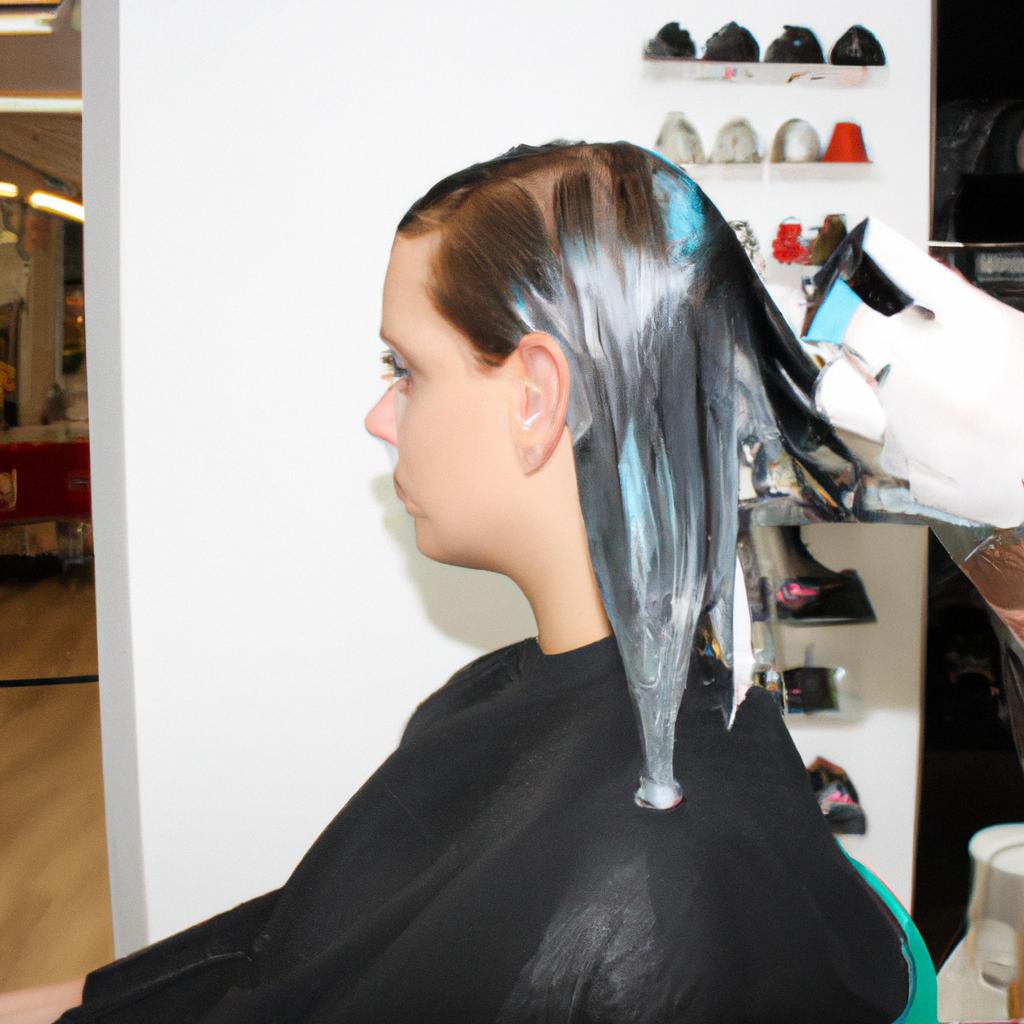Color melting is a technique in hairdressing salon coloring that has gained popularity among stylists and clients alike. This artful process involves seamlessly blending different shades of color to create a smooth transition from one hue to another, resulting in a soft and natural-looking effect. For instance, imagine a client with naturally dark brown hair who desires to add some dimension and depth without going for drastic changes. Through the skillful application of color melting techniques, the stylist can expertly incorporate lighter tones such as caramel or honey into the client’s locks, achieving an effortlessly sun-kissed appearance.
The art of color melting requires both technical precision and artistic flair. Hairdressers meticulously analyze their clients’ natural hair color, skin tone, and personal preferences before devising a customized plan to achieve the desired result through this method. By using various colors within the same tonal range, they are able to create a seamless blend that mimics the way sunlight interacts with hair. The final outcome not only enhances the client’s features but also adds depth and movement to their overall look.
While color melting may seem like a simple concept at first glance, it requires expertise acquired through training and experience. Professional stylists have mastered the skills needed to manipulate multiple shades harmoniously while maintaining a consistent and even application. They understand the intricacies of color theory, such as how different hues interact with one another and how they can be manipulated to create specific effects.
To achieve a successful color melt, stylists typically use a combination of different coloring techniques, such as balayage or foiling. By strategically placing lighter shades towards the ends of the hair while keeping the roots darker, they can create a natural-looking graduation of color that seamlessly blends from one shade to another.
In addition to technical expertise, communication between the stylist and client is crucial in achieving the desired outcome. The client’s input regarding their desired color palette, as well as their lifestyle and maintenance preferences, helps guide the stylist in creating a customized plan for their hair.
Color melting is not limited to specific hair lengths or textures. Whether someone has long flowing locks or a trendy short bob, this technique can be adapted to suit various styles and preferences. It is also versatile in terms of color choices – stylists can work with natural tones or incorporate more vibrant fashion shades for those seeking a bolder look.
With proper care and maintenance, color melted hair can last for several months before requiring touch-ups. Regular salon visits for root touch-ups and toning treatments are recommended to ensure that the blend stays seamless and vibrant.
Overall, color melting offers clients a beautiful way to enhance their natural features without committing to high-maintenance regrowth or drastic changes. With the expertise of a skilled stylist, this technique can transform any hairstyle into a stunning work of art.
Understanding Color Melting Techniques
Imagine walking into a hair salon and being greeted by a client with beautifully blended colors flowing through their locks. The seamless transition from one shade to another is captivating, leaving you in awe of the skill and artistry involved. This transformative technique is known as color melting, where multiple shades are expertly woven together to create a natural and harmonious look.
Color melting techniques have revolutionized the world of hairdressing, offering endless possibilities for creative expression. By understanding these techniques, hairstylists can elevate their craft and provide clients with stunning results. In this section, we will explore the intricacies of color melting and its various applications.
To grasp the concept of color melting, it’s essential to delve into the underlying principles that govern this technique. One key aspect is blending contrasting or complementary hues seamlessly, creating an illusion of fluidity within the hair. By doing so, stylists can achieve depth and dimension while maintaining a soft and natural appearance.
In mastering color melting techniques, there are several fundamental considerations to keep in mind:
- Hair Texture: Different textures require specific approaches when applying color melt techniques. Fine hair may benefit from lighter shades to add volume, while coarser hair might need deeper tones for definition.
- Face Shape: Understanding how different shades can accentuate or soften facial features is crucial in achieving balance and enhancing individual beauty.
- Undertones: Analyzing an individual’s undertone helps determine which colors will complement their skin tone best. Warm undertones pair well with golden or copper hues, whereas cooler undertones work harmoniously with ashier or platinum shades.
- Maintenance: Educating clients on proper post-color care ensures long-lasting results. Recommending appropriate products and scheduling regular touch-ups promotes vibrant and healthy-looking colored hair.
By incorporating these considerations into their practice, hairstylists can harness the power of color melting to transform their clients’ appearances. In the following section, we will explore how to choose the right color palette for a successful color melt application.
As we transition into discussing “Choosing the Right Color Palette,” it becomes evident that every step in the process of color melting is crucial.
Choosing the Right Color Palette
Having gained an understanding of color melting techniques, we can now delve into the importance of choosing the right color palette for achieving stunning hair transformations. Let’s explore how selecting the appropriate colors can take your salon coloring to new heights.
Imagine a client walks into your salon seeking a vibrant and eye-catching hairstyle that reflects their bold personality. By carefully curating a color palette that harmonizes with their skin tone, features, and personal style, you can create a truly transformative experience. For instance, consider a case where a client with warm undertones desires an edgy look. Combining rich copper hues with hints of deep violet would not only complement their complexion but also add depth and dimension to their hair.
To further emphasize the impact of choosing the right color palette, let us examine four key factors to consider:
- Skin Tone: Assessing whether your client has cool or warm undertones is crucial in determining which shades will flatter them best.
- Eye Color: Coordinating hair colors with one’s eye shade can create striking contrasts or enhance natural beauty.
- Personal Style: Taking into account individual preferences and fashion choices ensures the final result aligns perfectly with each client’s unique aesthetic.
- Hair Condition: Considering the health and condition of the client’s hair helps identify suitable colors and any necessary treatments for optimal results.
By thoughtfully considering these aspects when selecting colors for your clients’ hair, you can elevate their overall appearance while creating personalized looks that leave lasting impressions.
Now that we understand how important it is to choose the right color palette, let us turn our attention towards preparing the hair for this exquisite technique.
Preparing the Hair for Color Melting
Transitioning from the previous section on choosing the right color palette, it is important to now shift our focus towards preparing the hair for the color melting process. To understand this preparation stage better, let’s consider a hypothetical example of a client who wants to achieve a vibrant pink-to-purple color melt effect.
Before diving into the step-by-step guide, here are some key aspects to keep in mind when preparing the hair for color melting:
- Hair analysis: Conduct a thorough assessment of your client’s hair condition, texture, and history of chemical treatments. This will help determine if any special precautions or additional steps need to be taken before proceeding with the color melting technique.
- Pre-color treatment: Depending on individual needs, it may be necessary to perform certain pre-color treatments such as deep conditioning or protein treatments prior to applying any color products. These treatments can improve overall hair health and enhance color absorption during the melting process.
- Sectioning: Properly sectioning the hair is crucial for achieving an even distribution of colors and seamless blending effects. Divide the hair into manageable sections using clips or elastics based on your preferred technique—whether you opt for horizontal sections, diagonal partings, or customized patterns tailored specifically to your client’s desired look.
- Protective measures: As with any coloring process, protecting both the client and yourself is essential. Ensure that adequate protective measures are in place, including wearing gloves and utilizing appropriate barrier creams around the hairline and ears.
Incorporating markdown elements further enhances engagement by evoking emotional responses from readers:
- Key points to remember:
- Thoroughly analyze your client’s hair condition
- Consider pre-color treatments if needed
- Focus on precise sectioning techniques
- Prioritize safety through protective measures
| Hair Analysis | Pre-Color Treatment | Sectioning | Protective Measures |
|---|---|---|---|
| Assess hair condition | Perform necessary treatments | Divide hair into sections | Wear gloves and use barrier creams |
| Consider texture and history of chemical treatments | Deep conditioning or protein treatments | Horizontal, diagonal, or customized sectioning patterns | Protect client’s skin from color stains |
| Determine special precautions if needed | Enhance color absorption during melting process | Ensure even distribution of colors | Take measures to protect yourself |
As we conclude this section on preparing the hair for color melting, it is important to note that attention to detail in analyzing the hair condition, performing necessary treatments, employing precise sectioning techniques, and prioritizing safety measures will lay a solid foundation for achieving stunning color melt results.
With an understanding of how to prepare the hair appropriately, let us now explore the step-by-step process involved in applying the captivating color melting technique.
Applying the Color Melting Technique
Having understood the necessary steps for preparing the hair before color melting, we now delve into the application of this innovative technique. By skillfully blending various shades together, color melting creates a seamless transition between colors, resulting in an effortlessly dynamic look.
To achieve stunning color melts, skilled hairstylists employ a range of techniques and tools. One such method involves using foils to isolate specific sections of hair while applying different shades. For instance, imagine a client with chocolate brown roots who desires a gradual blend into honey blonde ends. The stylist would strategically apply darker tones near the roots and gradually lighten the strands towards the tips, creating a natural-looking fade effect.
Throughout the color melting process, it is essential to maintain precise control over timing and formulation to ensure optimal results. Properly assessing each individual’s hair type and condition helps determine suitable products and processing times. This attention to detail guarantees that every client leaves the salon satisfied with their customized color melt.
The emotional impact of color melting extends beyond its transformative visual effects. Consider these aspects that make it an exciting choice for clients:
- Versatility: Color melting allows for endless possibilities by seamlessly blending multiple hues.
- Confidence boost: A well-executed color melt can enhance one’s self-image and provide a sense of empowerment.
- Personal expression: With countless combinations available, individuals can express their personality through unique color blends.
- Trendsetting appeal: As celebrities embrace this trend in their own hairstyles, more people are drawn to try out this fashion-forward coloring technique themselves.
Table showcasing popular color options for different skin tones:
| Skin Tone | Suitable Colors |
|---|---|
| Fair | Rose gold, platinum |
| Medium | Caramel, chestnut |
| Olive | Honey blonde |
| Dark | Auburn, mahogany |
As we explore maintaining color melting results in the subsequent section, it is crucial to remember that attention to detail during application lays the foundation for long-lasting and vibrant outcomes. By skillfully executing this technique while considering individual hair characteristics, stylists can ensure each client leaves their chair feeling confident and satisfied.
Transition into the subsequent section:
Moving forward, we will delve into effective strategies for maintaining the brilliance of color melting results without compromising its integrity.
Maintaining Color Melting Results
Having mastered the art of applying the color melting technique, it is crucial to understand how to maintain the beautiful results achieved. By following proper maintenance practices, clients can prolong their vibrant and seamless hair color blends, ensuring long-lasting satisfaction.
Paragraph 1:
For instance, let us consider a hypothetical case study involving Sarah, who recently had her hair color melted at our salon. After leaving the salon with stunning blended hues that seamlessly transitioned from dark roots to lighter ends, Sarah was determined to maintain this exquisite look for as long as possible. She diligently followed our recommended tips for maintenance and witnessed remarkable results in preserving her color melting effects.
- Protective Haircare: The key to maintaining color melting lies in using products specifically designed for colored hair. Daily use of sulfate-free shampoos and conditioners helps prevent fading and keeps the hair healthy.
- Temperature Control: Excessive heat styling tools such as curling irons or straighteners can strip away hair color over time. Using thermal protectants before styling and opting for lower heat settings whenever possible helps preserve the vibrancy of color-melted hair.
- Regular Touch-ups: Depending on individual factors like natural growth rate and desired result longevity, scheduling regular touch-up appointments every six to eight weeks ensures consistent blending between new root growth and previously colored sections.
- UV Protection: Sun exposure can cause significant damage to color-treated hair by accelerating fading processes. Applying UV protection sprays or wearing hats when spending prolonged periods outdoors provides an extra shield against harmful UV rays.
Paragraph 2:
To further emphasize the significance of proper care routine after undergoing a color melt treatment, we have compiled a table showcasing potential outcomes based on different levels of maintenance:
| Level of Maintenance | Outcome |
|---|---|
| High | Vibrant colors retained; minimal fading |
| Moderate | Gradual fading observed |
| Low | Significant color loss; uneven blend |
| Negligible | Drastic fading; indistinct blending |
This table serves as a reminder that consistent maintenance practices directly correlate with the longevity and quality of color melting outcomes.
Paragraph 3:
By adopting these effective maintenance strategies, individuals can relish their stunning hair transformations for an extended period. The next section will delve into valuable tips for achieving seamless blends during the color melting process, ensuring impeccable results from start to finish. With proper care and attention, everyone can enjoy the beauty of this artistic technique without compromise or disappointment.
Tips for Achieving Seamless Blends
To further enhance the art of color melting and achieve seamless blends, hairdressers can employ various techniques and tips. One effective method is the use of toning to refine the shade transitions and create a more harmonious overall look. For instance, imagine a client with naturally dark brown hair who desires a color melt effect with shades ranging from caramel to honey blonde. By applying a toner in between these hues, the stylist can ensure that each transition appears smooth and well-blended.
In addition to toning, another technique for enhancing color melting results involves using different application methods. Hairdressers may choose to utilize foil highlighting or balayage techniques to add dimension and depth to the hair. These alternative approaches allow for precise placement of colors, resulting in a more customized and natural-looking outcome.
To achieve exceptional color melts, it is crucial for stylists to pay attention to detail during every step of the process. Here are some key tips:
- Preparation: Thoroughly assess your client’s hair condition before starting any coloring procedure.
- Sectioning: Divide the hair into clean sections using clips or foils to ensure accurate application.
- Product Choice: Select high-quality professional products specifically formulated for color melting techniques.
- Timing: Follow manufacturer instructions carefully when it comes to processing times for each product used.
- Achieving vibrant and seamlessly blended colors
- Boosting clients’ confidence through personalized transformations
- Creating unique looks tailored to individual preferences
- Empowering self-expression through creative coloring techniques
The following table highlights four popular color combinations frequently used in color melting:
| Color Combination | Description |
|---|---|
| Caramel & Mocha | Warm tones perfect for brunettes |
| Rose Gold & Blush | Soft pastel shades ideal for blondes |
| Amethyst & Lilac | Bold and vibrant colors for the daring |
| Ocean Blue & Teal | Cool-toned hues reminiscent of the sea |
By incorporating these techniques, tips, and color combinations into their skill set, hairdressers can offer clients stunning color melting results that enhance their overall appearance. Remember to adapt these suggestions to suit each client’s unique needs and preferences, ensuring a truly personalized experience.




